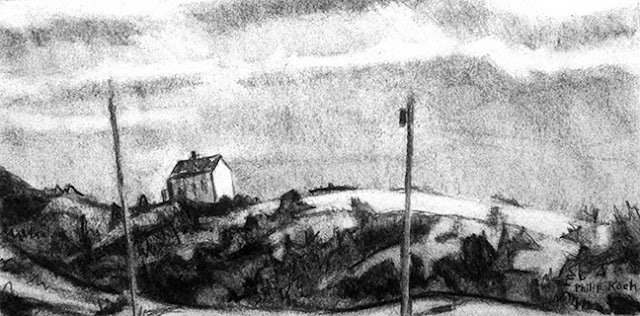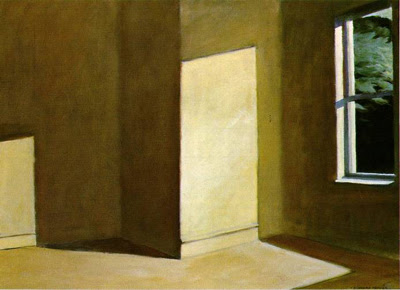Strange Connections, Hopper, Harris and a Turn in the Road
One of the reasons I like being a painter instead of an art historian is I'm free to wander a bit more in my thinking. Artists love to make comparisons that jump from one artistic category to another. For example I was just looking at (alright, no surprise here!) Edward Hopper and the Canadian painter Lawren Harris (1885-1970). It hit me how the two, despite their difference in style, were instilling extra energy into their paintings with similar tools. Here's Hopper's wonderful oil of his neightbor Burly Cobb's place, which was just over the hill south of Hopper's studio on Cape Cod.
I love his contrast of the big, open areas of the shingled roof played off against the much more abrupt rhythms of the smaller oblique roof shapes and chimneys at the lower right of the painting. Hopper was a master of giving his viewer big massive forms and then contrasting them against something small, sharp and unexpected. Any painter can do that, of course, but Hopper binds the very differently scaled forms together into a tight little conversation. Sometimes it's so beautiful I could look at it all day.
It's easy to think Hopper just "painted what he saw" of course. He didn't. Instead he doggedly pursued making paintings that expressed his more internal, emotional side. In Hopper's day, the then largely deforested Cape Cod looked in many places like a big, wide open panorama. This photo I took of Hopper's studio last fall during my most recent residency there is a perfect example of the typical landscape Hopper actually had before him.
It shows little of the more densely packed imagery that so often made Hopper's paintings special. Hopper went for the more unexpected view, the combining of the broadly open form with something surprisingly intricate. It gave his work a freshness of seeing that we feel all these years later.
Below is a painting by one of Hopper's contemporaries, Lawren Harris, another of my favorites. Harris was little known in the U.S. and probably Hopper had never heard of him. Yet in so many ways, the moves Harris employs to energize his paintings are so similar to Hopper's. Like Hopper's massive roofs above, Harris gives us this big monolith of land projecting out into Lake Superior.

The huge dark land mass at first looks almost flat. Then your eye picks up little eccentricities like the subtle changes within the dark form that break it up into three or four separate cliffs. Harris tells you he's found this big, brutish mass of a hillside that wants to impress you with its size. But, he adds, if you stay around a little longer, intriguing individual component parts would be happy to reveal themselves to you. He hints at it with understatement instead of highlighting every detail. I'm in love with the syncopation of the rhythms at the very top of the dark hillside. Along the top of the hill at the right all is smoothed together into a rounded simplicity against the sky. But that's too simple left by itself, so as your eye moves to the left Harris gives you five sharp vertical trees that stant out from the crowd. It's like a tiny decorative accent on someone's otherwise restrained business suit, giving your eye just a little moment to be surprised and deligted.
I myself am entering a new period. Over the Fall and early winter I was all ramped up preparing for my second solo show at George Billis Gallery in New York ( today, Saturday, Jan. 19 is its last day). And I just opened a second major show at Friends School of Baltimore (through Feb. 15). Now that the work for these shows is complete, I can turn my eye back towards making new paintings. There are some works in progress from last summer calling out to me. And I've got some new ideas simmering in the back of my mind that will be making their debut appearances too.Don't feel bad for me, locked away in my studio with no one to talk to. I get out a lot. Last week I spoke to an audience of 400 students about my painting at Friends School in Baltimore and then just the next day drove out to Hagerstown, MD to speak to about 35 people at the lovely Washington County Museum of Fine Art. Here's a clipping about that from the Hagerstown Herald Mail.
(Click on the article for a larger version).





